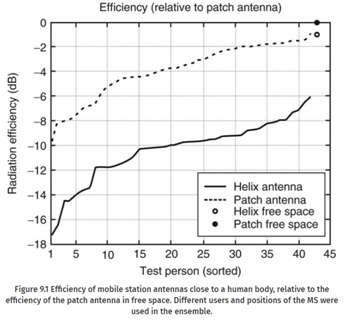Reference no: EM132359718
Question 1. A BS for GSM900 MHz has output power of 10 W; the cell is in a rural environment, with a decay exponent of 3.2 for distances larger than 300 m. The cell coverage radius is 37 km when measured by the MS in the absence of a user. Calculate how much smaller the coverage radius becomes for the median user in Figure 9.1 when she/he places the cellphone in close proximity to the head.

Question 2. Consider a helical antenna with d = 5 mm operating at 1.9 GHz. Calculate the diameter D such that polarization becomes circular.
Question 3. Compute the input impedance of a half-wavelength slot antenna; assume uniform current distribution. Hint: the input impedance of antenna structure A and its complement B (a structure that has metal whenever structure A has air, and has air whenever structure A has metal) are related by
Z A Z B = Z 204
where Z0 is the free-space impedance Z0 = 377Ω.
Question 4. Consider an antenna array with N elements where all elements have the same amplitude, and a phase shift:
Δ = - 2Πλda (30.18)
• (a) What is the gain in the endfire direction?
• (b) What is the gain in the endfire direction if
Δ = - [ -2Πλda + ΠN ] (30.19)
Question 5. A directional coupler has a directivity of 20 dB, an insertion attenuation of 1 dB, and a coupling attenuation of 20 dB. The reflection coefficients of all ports (with respect to the nominal impedance of Z0 = 50Ω) are 0.12, and the phase shift in the main path is 0, in the coupled path π/ 2, and 0 between the decoupled paths.
• (a) Compute the S-matrix of this directional coupler.
• (b) Is the directional coupler passive, reciprocal, symmetrical?
Question 6. Consider the concatenation of two amplifiers with gains G1, G2 and noise figures F1, F2. Show that in order to minimize total noise figure, the amplifier with the smaller value of
M = F - 11 - 1 / G (30.20)
has to be placed first.
Question 7. An amplifier has cubic characteristics:
Uout = a0 + a1 Uin + a2 U2in + a3U3in
Let there be two sinusoidal input signals (with frequencies f1 , f2) at the input, both with a power of -6 dBm. At output, we measure desired signals (at f1 , f2) with 20-dBm power, and third-order intermodulation products (at 2 f2 - f1and 2 f1 - f2) with a power of -10 dBm. What is the intercept point? In other words, at what level of the input signal do intermodulation products become as large as desired signals?